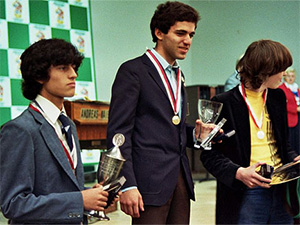While voicing serious concerns with a grandmaster about the inflation of international chess titles and their dwindling value, the grandmaster agreed there was reason to worry, but then added “still, a GM is a GM to be fair.” Is it? Many players view the issue as a relatively recent phenomenon, as if it were just a minor issue of Elo adjustment over the last decade, but the issue goes much deeper and further. Since its adoption and creation by FIDE in 1950, the title has not only changed in its requirements, but its very definition.
History of the grandmaster title
When FIDE first awarded the grandmaster title in 1950, it was bestowed upon 27 players of the day, which included world champion Mikhail Botvinnik and all those who had qualified or been seeded in the inaugural Candidates Tournament: Isaac Boleslavsky, Igor Bondarevsky, David Bronstein, Max Euwe, Reuben Fine, Salo Flohr, Paul Keres, Alexander Kotov, Andor Lilienthal, Miguel Najdorf, Samuel Reshevsky, Vasily Smyslov, Gideon Ståhlberg, and László Szabó.
It was also given to players still living who, though past their prime in 1950, were recognized as having been world class at their peak: Ossip Bernstein, Oldrich Duras, Ernst Grünfeld, Borislav Kostic, Grigory Levenfish, Géza Maróczy, Jacques Mieses, Viacheslav Ragozin, Akiba Rubinstein, Friedrich Sämisch, Savielly Tartakower, and Milan Vidmar.
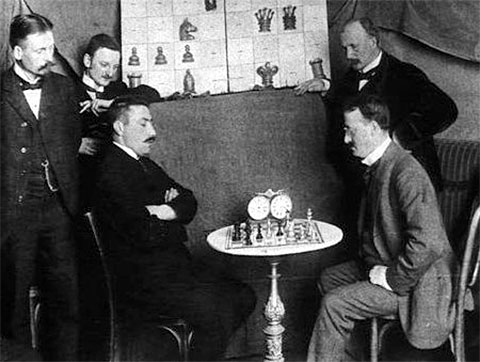
Jacques Mieses playing Akiba Rubinstein in 1909. 41 years later FIDE could not
fail to recognize their stature.
The standard used for the title was clear: a grandmaster was someone who was recognized as a world-class player at some point in their career. As the process advanced, clear criteria needed to be established for future title contenders.
Under the 1957 regulations, the title of International Grandmaster was automatically awarded to the world champion and to any player qualifying from the Interzonal tournament to play in the Candidates Tournament. It is worth noting that it was under these conditions that Bobby Fischer became the world’s youngest grandmaster at age 15, when he qualified for the Candidates tournament. Looking at it in today’s eyes, one might conclude these draconian conditions were ridiculously tough, but when FIDE convened in 1965 with the purpose of revising the rules, the prevailing opinion was that the 1957 rules were… too easy!
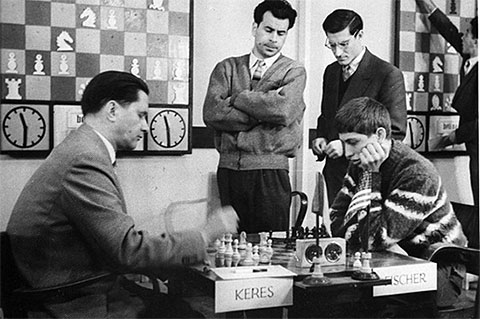
When Bobby Fischer was awarded the grandmaster title at age 15, it was because
he had qualified as a world championship contender.
At the FIDE Congress in 1961, GM Milan Vidmar said that the regulations "made it possible to award international titles to players without sufficient merit", and when FIDE convened in 1965 to revise them, GM Miguel Najdorf echoed Vidmar’s concerns, and stated that the existing regulations were leading to an inflation of international titles. As a result, the rules were tightened up, and now the grandmaster candidate had to score 40% in the Candidates Tournament, or reach the quarter finals of the Candidates Matches. This is what was expected of a player holding the grandmaster title.
Although this undoubtedly kept the prestige of the grandmaster title immaculate, it was probably a little overprotective. The consequence of the new regulations was that in 1966 only one title was conferred and the same was true again in 1968.
In 1970, the modern system for awarding titles was presented at the FIDE Assembly at the Siegen Chess Olympiad with proposals by Dr. Wilfried Dorazil, then FIDE Vice-President, and fellow Committee members Svetozar Gligoric and Professor Arpad Elo. These changes were based on the widespread adoption of the Elo system by FIDE and its role in awarding the grandmaster title. At the time, a rating performance equivalent to 2551 was enough for a norm, and the rating required was 2450. Just as today, the player needed three norms, but at the time the three norms had to be scored within a three year period. Eventually the rating requirement was raised to 2500 as the ratings rose and the preservation of the title’s value became a concern.
Lowering the standards
To put this into perspective, in 1973, 40 years ago, a Grandmaster norm performance was the equivalent of a player ranked in the top 20-40 players in the world. This was still true ten years later in 1983, and it is worth noting that the 2450 rating required to become a grandmaster was still quite close to the world top 100, where the 91st to 100th players were rated 2485, and included Boris Gulko, Joel Benjamin, and others.
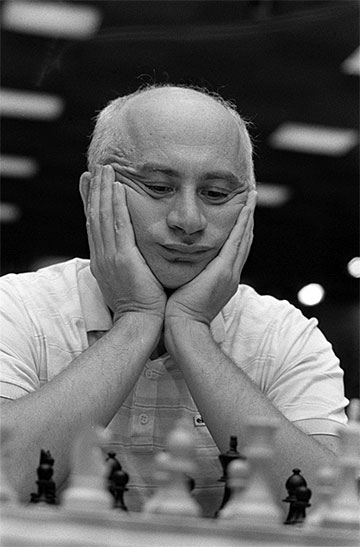
In 1987, Boris Gulko was barely 25 Elo above the minimum to be
recognized as a grandmaster, yet that ranked him 80th in the world.
By 1993, 20 years ago, things had changed significantly after several inflationary rules did their damage, such as a rule in which a tournament winner could not lose Elo, and the GM norm was now the equivalent of a player ranked in the top 60. Today, in 2013, a GM performance equates to a player ranked in the top 250, and the minimum rating to earn the title, which 30 years ago would have almost had you in the top 100 players, would now rank you around 930 in the world.
A GM is a GM? The title may be the same, but the definition and expectation of the title have clearly changed. Assuredly there are more strong players than ever before, but the grandmaster title was not an exam one passed with a diploma at the end, it was a stamp of prestige that implied world-class ability. Still, the trend of the devaluation of titles does not stop there.
The trickle-down effect
A few special cases were also introduced over time, such as winning the World Junior Under-20 Championship. At first, this prestigious championship, won by players such as Kasparov, Karpov, Spassky, and even top players of today such as Anand, Aronian, and Mamedyarov, earned the player the International Master title. As time passed this was upgraded to earn the winner a grandmaster norm, until finally in 2004 it was deemed worth the title outright. From a purely Elo perspective this would seem to make sense. After all, by 2004 there were no sub-2600 winners, so the promise of the title was never actually put into practice. Unfortunately this has also led to an alarming trickle-down effect to other titles.
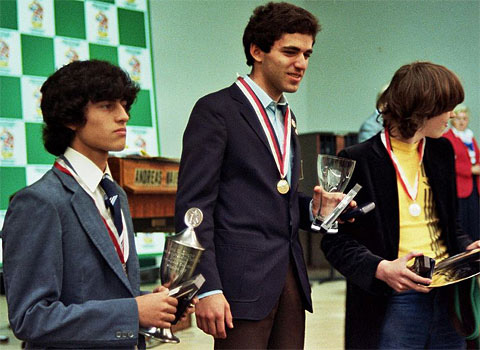
Garry Kasparov, winner of the World Junior Championship in Dortmund in 1980.
Second was Nigel Short (right) and third Chilean IM Ivan Eduardo Morovic (left).
Until now, the discussion has been the nonstop devaluation of what it means to be a grandmaster and the devaluation of the title itself, but this affects all other titles as a result. The reason is that all titles are actually proportionate to the grandmaster title. The requirements to become an International Master (IM) are the same as those of a Grandmaster except the rating required is 100 below. This is how it was even in 1970.
In 1978 the FIDE Master (FM) title was introduced and today the requirement is that a player be rated 2300 FIDE, which is 100 below that of the IM, or 200 Elo below that of the Grandmaster. There is also a Candidate Master (CM) title for players who reach 2200. No norms are required for these last two titles, and they are strictly dependent on one’s rating. Although there has never been any question about these titles suggesting world class ability, the problem comes with the alternate ways one can achieve these lifetime titles.
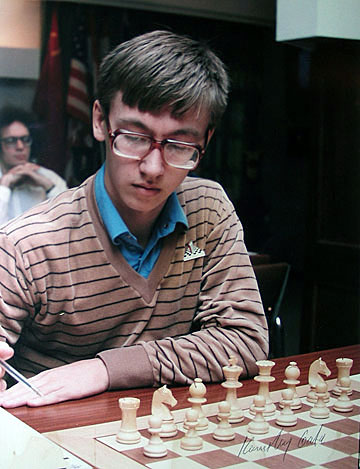
Gata Kamsky is the highest ranked player ever to not be a grandmaster,
when at age 16, and still untitled, he was 8th in the world with 2650 Elo.
One example is that one can become a FIDE Master for life by winning an event such as the Pan-American under eight championship. One might think this means that these chess-playing seven-year-olds are in fact playing at 2300 strength, but the fact is you will not find a single one of these players rated even 2000 FIDE much less 2300. So why are they receiving titles that suggest a 2300 playing strength? Good question.
As of July 1st, FIDE will expand on this title generosity, by providing a free-for-all for the Candidate Master title, which is a lifetime title conferred to players who are rated 2200 FIDE. The idea of a title to allow players, unable to achieve grandmaster status, to show they reached a dignified level of skill is commendable, but what is one to think of FIDE regulations that then guarantee the title to a six-year-old player for coming third in the Continental School under-seven championship despite being rated hundreds of Elo below the requirements? What value does the title have then?
It is obvious that the strict definition of a grandmaster as a world-class player no longer holds true, but there is a vast difference between a world-class player and one ranked no.930 in the world. It would be a tragedy for FIDE to let its most prestigious title, and aspired goal, dwindle down to mediocrity.
Solution
So what is the solution? If FIDE acknowledges the problem and wishes to revert this worrisome direction, then strong measures need to be taken. When the Elo system was implemented by FIDE in 1970, no provisions were made for possible ratings inflation and subsequently the titles, as a result, only one 50 Elo adjustment has been made in the last 40 years. Since then the rating of the 100th player has risen approximately 150 Elo.
To those who would argue that it is due to an increase in stronger players, realize that the difference between the 10th and 100th player has not changed in over 40 years. For example, in 1983, the world no.10 was 115 Elo stronger than the world no.100, and today in June 2013 the difference is 109 Elo.
In theory this would seem to indicate a need to recalibrate the title requirements, rating and norms, by 150 Elo, but a compromise would be a 100 Elo raise so that new grandmasters entering the list would still be in the top 240 players, instead of the 930th as is the case now. To prevent the problem from getting out of hand again, FIDE would implement a practice of regularly re-examining the requirements every five years and recalibrating them, if necessary, according to the lowest rating of the top 200-250 players.
As to the distribution of Elo-based titles such as FIDE Master and Candidate Master to players who have not proven their worthiness in any way or form, cease the practice immediately, as this not only besmirches the value of the title, but is an insult to players who earn them through dedication and skill. Otherwise, why stop there? Just declare them all grandmasters.
